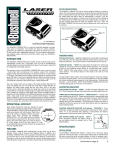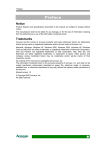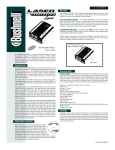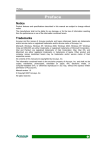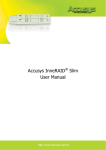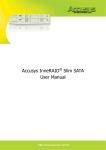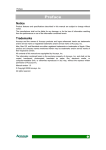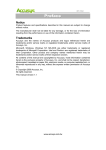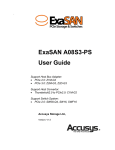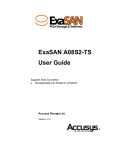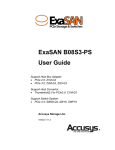Download Accusys ACS-61100 User's Manual
Transcript
A AC CS S6 61 11 10 00 0 Familiarizing yourself with the ACS-61100 RAID Card What you’ll need… Quick Start Guide SATA II Hard Disk Drives (the number will vary depending on the RAID configuration). Welcome Thank you for purchasing the ACS 61100 PCI Express to SATA II RAID Host computer with spare PCI-e slot. adaptor. This model provides the latest functionality and performance for Disk storage and power connection for each drive. Windows, Linux and MAC operating systems. And with a Java based GUI the RAIDGuard X server and client software offers improved functionality Static grounding strap or electrostatic discharge (ESD) safe work area. and manageability. What's in the box… Optional items… This guide ACS-61100 RAID PCI-Express to SATA controller card. Battery backup module to back up cached data in the event of a power failure. Installation CD-ROM including: user manuals for RAIDGuardX and 61100; JRE, Drivers and RAIDGuardX Client and Server. LCD Control Panel for Card status and advanced configuration. 1. DDRII memory connector Mini Multi-Lane iPass cables (50cm), including SGPIO connector. 1 Card Installation Hard Drive Connection 1. Card Installation 1. Remove the blanking plate from the PCI-e slot. 2. Position the connector of the card over the expansion slot. 3. Press the connector of the card gently but firmly into the expansion 2. 3. slot until it is correctly and securely seated. 4. 5. 2. I2C connector 7. Serial port connector 3. Mini SAS connectors 8. Button port connector 4. Disk access LED connector 9. LCD panel connector 5. Disk fault LED connector 10. Battery module connector 2 3 Initial Setup Software Installation The easiest way to start is to run the Quick Array Configuration from the The details below are applicable only to the Microsoft Windows operating control a maximum of 4 HDDs. BIOS. system. For other operating systems see the User Manual. Install the disks in the desired location eg within the system case or in an BIOS independent disk rack. 1. First insert the CD into the CD-ROM drive of the server and/or client. Choose the required application from the on-screen menu. Start the server and watch the screen. When it gets to the position shown Installing Java Connect the other end of each cable to the connectors on each of the below press Enter. It is necessary to install Java Runtime Environment v1.5.09 or later. For the hard drives. Secure the metal bracket of the card to the system case with a screw. latest version see www.java.com. 4. Go to the Hard drive connection. Attach Mini SAS cables to the connectors on the card. One cable can 6. PCI-Express x 8 connector Attach a power connector to each drive, either from the host system or From the on-screen menu choose to install Java. from an independent power source. Installing RAIDGuardX server RAIDGuard X server is the application that runs on the host server that the 61100 is connected to. Once it is installed correctly the controller can be monitored from any remote computer with Java installed. From the on-screen menu choose which operating system to install for and follow the on-screen instructions. Installing RAIDGuardX Client From the on-screen menu choose which operating system to install for and follow the on-screen instructions. Note: The hard drives in a RAID should match in size and speed. All drives in any array should be identical models with the same firmware versions. Arrays only support LBA 48 bit HDDs (bigger 128GB), however, the smallest drive will determine the size of the array. 4 2. Enter the password (the default is 00000000 (8 zeros) and press Enter. 3. Go to RAID Configuration > Create Array > Quick Array Configuration. The BIOS will recognize how many drives are installed 5 and provide the best solution. Type "Y" to begin configuration. 6 7 RAIDGUARDX Server Error Alerts Creating and Deleting an Array Slicing Run the server application when you want to connect to the controller card. Administrators can choose how best to distribute the disks available. Once an Error alerts are activated when a problem occurs with the RAID controller or Hard drive slicing partitions the drives of an array so that it appears as a 1. Start the RAIDGuardServer from Start > Programs > Accusys > array has been created or deleted it can be further administered. array. The alerts can be detected in two ways: separate volume. RAIDGuardServer. Follow the steps to create an array. Beeper - An audible alarm sounds when an error has occurred. To set the Follow the steps below to select an array to slice or merge. beeper: 1. 2. The RAIDGuardServer icon will be displayed in the Windows notification area. Basic Configuration 1. Click the Create Array icon 2. Select the level from the drop down menu. Available levels are: 0, 1, 0+1, 3. . 2. 2. Select the stripe size from the drop down menu. Available stripe sizes E-Mail - E-mails are sent to administrative staff when and error or event Click OK to set the beeper. Start RAIDGuardX Client either click the desktop icon or go to Start > Programs > Accusys > RAIDGuardX Client. Click the Email icon 2. Enter the e-mail addresses of recipients (max 20). Performance Evaluation. 3. Enter the SMTP Server name and e-mail address. 5. To automatically assign a LUN check the box. 4. If required enter the SMTP user name and password. 6. Click Create Array to complete the process. 5. Click OK. LUN Map . Click the drives to be added to the array. A LUN is a unique identifier used on a SCSI bus that enables it to differentiate between up to eight separate devices. Use the LUN map to attach a unique identifier to a slice. Add a controller by clicking the 3. Click the controller to administer and enter the password. The default in another array or reconfigured for a new array. password for the 61100 is 00000000 (8 zeros). Click Add. Follow the steps below to delete an array. Follow the steps below to map a LUN. Deleting an array removes the selected array and allows the drives to be used Follow the steps to below to either add another array or configure the existing one. Advanced Configuration 1. Click the Delete Array icon 2. Click on the disks containing the array to be deleted. 3. Check the Confirm box when you understand that all the data on the Select the Array to map. 2. Choose a LUN and from the drop down list select a series to map to. 3. Check the Confirm box and then click OK. Expansion The Options menu provides the methods for changing the details of the array. Click the required option and then click Next to proceed. Expansion allows the adding of extra drives to an array with the need to rebuild the array. Follow the steps below to select an array to expand. 1. Select the array to add additional disks to and select the number of disks to be added. A “+” sign is added above the disk(s) to be added. Click Delete Array to complete the process. 2. 8 a 9 Check the Confirm box and then click Expand Array. b FAQ Migration Health Center Migration allows RAID types to be changed, for example from RAID level 1 1. Q: RAIDGuard X server displays the “Find no RAID Card” window. A: Make sure that the controller card is connected inserted. The health center can help to resolve any problems with the array. 2. Q: Hard drives aren’t being displayed in the RAIDGuard X Client to RAID level 5, without the need to delete the array and rebuild. Follow the steps below to select an array to verify, rebuild or condition. Follow the steps below to select an array to migrate. 1. Select the Array to verify, rebuild or condition. 1. 2. Click the radio button to Rebuild parity data, Verify parity data or Refresh Select the Array to migrate. From the drop down menu select the RAID Level to Migrate to then select the Total Drives to include in the above the disk(s) to be removed. A: Make sure that the Mini SAS cables are correctly installed and that the hard drives have power. 3. Q: The software has stopped working correctly. 4. Q: Updating Firmware, Boot Code or Option ROM doesn’t work correctly. Med or High). 3. A: Do the following: 1) Check that the correct version is being installed eg, if, when updating the Click OK to start the operation. firmware the BIOS software is selected then the following message will be displayed Check the Confirm box and then click Migrate. “Command Failed”; 2) Don’t unzip the .gz file 3) Download the file again. Unlock drives Snapshot 5. Q: E-Mail alerts aren’t working. Locked drives are drives that for one reason or another have stopped being A: Check that the correct details are inserted and that if a username and password are required they are inserted. See your network administrator for details. The snapshot function mirrors the data from one slice onto another thereby recognized by the controller. backing up the data. Follow the steps below to select a drive to unlock or change the ID. Follow the steps below to take a snapshot: 1. Select the drive with the 1. Select Create Shot. 2. Check the Confirm box and then click Unlock Drive. 2. Select the shot, Source Slice and Destination Slice. 3. Check the Confirm box and then click OK. icon. It will change to the Contact Us icon. Note: The destination slice must be the same size or bigger than the Updating ACS-61100 Firmware, BIOS and ROM source slice. 1. Download the latest firmware from www.accusys.com.tw. 2. Start the RAIDGuard X client. 3. Add a controller. 4. Click Controller > Update > Update Firmware, Update Boot Code or Update BIOS & EFI. 5. c A: Restart the remote computer or server. If this doesn’t work, insert the Installation CD into the computer/servers CD-ROM drive, click Setup > Next > Repair > Install > Finish. array data and parity (for this option choose the priority between Low, array. A “+” sign is added above the disk(s) to be added and a “-“ sign 2. 1. Options . disks will be lost. 4. Check the Confirm box and then click OK. occurs. To set e-mail alerts: 2. Add Controller icon. Click the slice to create and use the slider bar or buttons to adjust the size. Click OK to complete. 3. Optional: From the drop down menu select either On The Fly Initialization or the 61100 remotely from any computer with Java installed. 1. number. > Mode tab > Check the Beeper box. 1. 4. The RAIDGuard X Client is responsible for monitoring and administering Click the Preferences icon 5, 6, 0+1, and JBOD. are: 8-256KB. RAIDGuard X Client 1. Select the array to slice or merge by clicking on a disk with an array Go to the location of the downloaded files and click Open. d Taiwan - Accusys, Inc. Address: 5F, No.38, Taiyuan St., Jhubei City, Hsinchu County 302, Taiwan, R.O.C Tel: +886-3-5600288, Fax: +886-3-5600299 http://www.accusys.com.tw/ e-mail: [email protected] America - Accusys U.S.A., Inc. Address: 46710 Fremont Blvd. Fremont, CA 94538, U.S.A. Tel:+1-510-661-0800, FAX:+1-510-661-9800 Toll-free number:+1-866-277-5888 http://www.accusysusa.com/ e-mail : [email protected], [email protected] Korea - Accusys Korea, Inc. Address: Baegang B/D 5F Shinsa-Dong 666-14 Kangnam-Gu, Seoul, Korea Tel : (02)6245-9050, Fax : (02)3443-9050 http://www.accusys.co.kr/ e-mail : [email protected] China Beijing- Accusys China, Inc. B1701, Horizon International Tower, No.6, ZhiChun Road, HaiDian District, Beijing Tel: +86-10-82800080 Fax: +86-10-82800784 E-mail: [email protected] http://www.accusys.cn Europe - Accusys EU B.V Address: Columbusstraat 2-10, 3165 AD Rotterdam, Netherlands Tel : +31-10-4284117 Fax : +31-10-4284114 http://www.accusyseu.com, ftp://ftp.accusyseu.com E-mail : [email protected], [email protected] e P/N: 42-34000-5013




